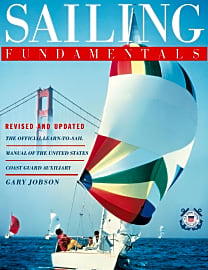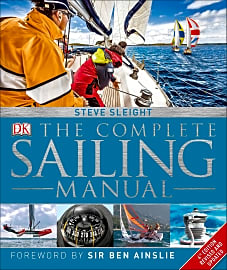The 10 Best Sailing Books

This wiki has been updated 39 times since it was first published in August of 2015. If you're contemplating a life on the ocean waves or are already an accomplished captain who wants to improve his or her knowledge and skills, one of these sailing books will both enlighten and encourage you. We've included editions suitable for day cruisers looking to brush up on their techniques through to circumnavigation epics to inspire even the most experienced seafarers. When users buy our independently chosen editorial recommendations, we may earn commissions to help fund the Wiki.
Editor's Notes
March 04, 2019:
Sailing books cover the gambit from adventure-filled fiction or true accounts of epic around-the-world trips to reference style guides that teach everything from basic launching techniques to achieving the proper trim and increasing downwind speed. We wanted to make sure that we included at least one or two options to suit every need. If you are a newbie who is just getting into cruising, you would be well served with Sailing Fundamentals, The Complete Sailing Manual, Sailing For Dummies, or Fast Track to Sailing. Many intermediate and advanced sailors will also find much of the information in The Complete Sailing Manual useful too. If you have spent a some time on the water already and want a detailed manual of useful techniques to help you improve your burgeoning skills, The Annapolis Book of Seamanship is one of the best options. Those who are just looking for enjoyable reads or perhaps hoping to find something that will inspire them to take the leap and become a full-time, liveaboard who spends their days tackling the high seas, experiencing exotic cultures, or enjoying happy hour at 12:00 in the afternoon will definitely enjoy Sailing Alone Around the World, Escape from the Ordinary, and A Sail of Two Idiots. If you draw your inspiration from stunning photography, you won't be disappointed with Onne van der Wal's Sailing.
Who Benefits From Sailing Books?
While sailing books are a relatively niche pick, the pages within often express truths about life which favor any reader.
For the apprentice sailing student, picking up a sailing book from a reputable sailor has the obvious benefit of teaching the basic concepts of sailing. Books also allow for the concepts to be studied and theoretically mastered before practical application is necessary. This gives new sailors a better level of confidence in their abilities. This may be the safest way to approach learning how to sail, as thousands of injuries and deaths occur each year due to avoidable boating accidents. Removing human error by thoroughly understanding sailing and safety concepts is the best way to avoid these accidents.
Sailing books also cater to different types of learners. While there are a great number of experiential learners in the world who need hands-on application to understand concepts, visual learners and readers often require more theoretical approaches first. Sailing books cater to these needs very well.
The interest in sailing may be for career choices as well. Sailing vessels have been explored for use in oceanography for years, due to their reduced fuel consumption, noise, and impact on the environment.
While sailing books are a relatively niche pick, the pages within often express truths about life which favor any reader. Seeing things from the perspective of a learned author or explorer may bring to light new ways of understanding life an its inherent ebbs and flows.
Examples Of Concepts Covered In Sailing Books
Sailing books offer a large amount of theoretical knowledge which must be learned before any practical knowledge is gained on the water.
It is also interesting to note that there is little to no wind near the surface of the water.
Other than the basic parts of a boat, the air flow of a sail is possibly the most important aspect of sailing to understand. As the wind is the sailboat's motor, a general understanding of these aerodynamics is necessary to know why sailing works. Researchers note that the wind speed is greater in a wind tunnel as it moves up the mast. It is also interesting to note that there is little to no wind near the surface of the water. These aerodynamic concepts help sailors understand how a sail will act in certain winds and better prepare them for executing different points of sail.
The points of sail are the terms covered in most sailing books which are used to describe the angles of the sail in relation to the wind. In general, boats are built to be able to sail within 45 degrees of the wind. This means there is a 90-degree zone in which regular sailing is unfavorable or impossible. Different angles of the sale, or points of sail, change as the boat and winds change course, and need constant adjustment to capture the wind efficiently.
Sailing as close to the wind as possible is the close-hauled position. As the boat steers away from the wind, the sails ease into a close reach and then ease further into a beam reach. A beam reach is where the wind is blowing over the side or beam of the vessel. Still further eased sails will end in a broad reach. Sailing directly away from the wind with sails eased all the way out is called a run. These points of sail scratch the surface of the basic physics of sailing covered in many sailing books.
Tacking; Persistence In Sailing
The basic concept of sailing involves allowing the wind to propel a vessel towards its destination. When the destination lies directly upwind, this is theoretically impossible.
Tacking involves coming about, or turning the bow of the ship into the wind, so that the direction the wind blowing into the sails changes from one side to the other. The combination of tacking and its opposite, jibing, allows for more constant movement at sea. This even enables a vessel to sail without a rudder.
Tacking involves coming about, or turning the bow of the ship into the wind, so that the direction the wind blowing into the sails changes from one side to the other.
Tacking is an essential maneuver for efficiently sailing a ship, as ideal winds are not always possible. In practice, conventional sailing ships set the sails at 45-degree angles to the wind. The tack is performed for a short distance before is reversed to tack the other way. A series of these moves performed in a zig-zag pattern is called beating, and allows for vessels to make progress against the wind. While beating, a ship will take a point of sail position called close-hauled. This stems from an aerodynamic concept of sailing as close to the wind as possible while still moving relatively forward.
In reality, the vessel moves diagonally with each tack, keeping the intended direction as its center. The time between switching the direction of a tack depends greatly on the size of the body of water and the strength of the wind. In a small channel, tacks may be performed every few minutes. On the open ocean, tacks may only be required every few days. Since conditions are always changing, a sailor must always be ready to evaluate each tack to ensure it is still favorable.















